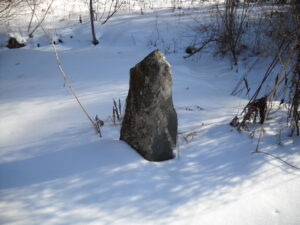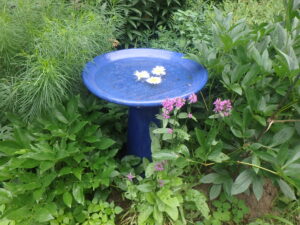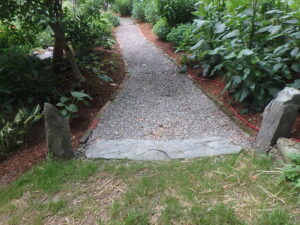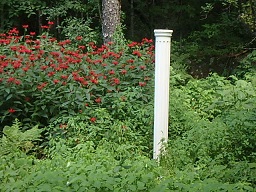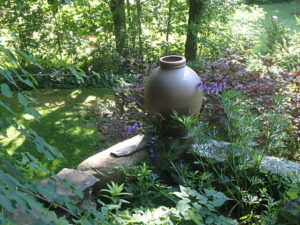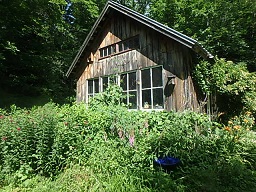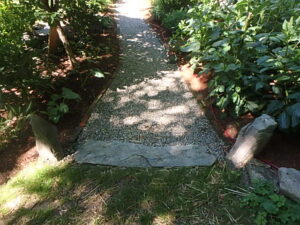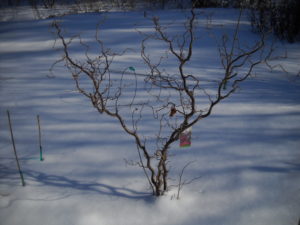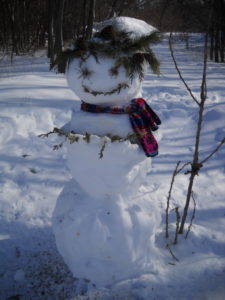It’s Time to Reflect on Our Gardens
The bones of the garden are the trees, shrubs, stone walls, sculpture, water features and pathways. These are visible in winter, though often covered in snow. In summer they can become focal points, or almost disappear as flowering plants shout out for attention.
Alternatively, you can plant trees. There are advantages to this: trees get bigger and better every year. They provide habitat and food for birds, pollinators and all sorts of small animals. They reduce water runoff. And although some require occasional pruning, most of Mother Nature’s trees do just fine on their own. Some are fast growing, others will just inch along, holding place without shading the understory.
Water features are nice, too. A simple birdbath can add interest and provide water for insects and birds. I have a blue ceramic birdbath that adds color and height to a flower bed – even though the birds seem to ignore it. I was told to put a stone in the water for them to perch on, but even that has not lured them in. Of course, I have a brook nearby, so that is probably their choice instead.
Pathways are important to gardens. They can keep your shoes out of mud and protect the soil from erosion. Flat stones are great, as are pea stone or small gravel. Chipped branches or bark mulch can be used for walkways, too. Pathways naturally lead one forward to other parts of the garden. Grassy paths are simple, and work well so long as they are not worn bare by too much foot traffic.
Beyond Perennials: Making Your Garden a Very Special Place.
My garden is the place I go in times of sadness, worry or stress. It makes me feel better. I took a few moments one morning recently to really look at what was in my garden to see what made it so special. I saw that in addition to the plants (and who cannot be happy snacking on red raspberries or Sun Gold cherry tomatoes?), I have many things that remind me of friends, and of good times. Let’s take a look at my garden, and perhaps you’ll get some inspirations for what to do in yours.
I have three nice Japanese red maples that bring fond memories. Two came from my parent’s home in Connecticut, another from a friend. I dug 2 them as foot-tall saplings, one bigger. The one I planted in the early 1970’s and it is now 10 feet tall and wide with a 6-inch diameter trunk at the base. I see it and often think of the 60-foot tall “mother plant” I climbed as a boy.
Other things are easier than stone projects. I have two nice blue ceramic bird baths. They contrast nicely with the flowers around them, even though no birds ever bathe there. But I love the water in them, and that my wife Cindy Heath floats cut flowers in them. (Yes, my longtime partner and I finally got married July 1 in a Zoom wedding attended by loved ones all over.)
I have a lovely high-temperature fired urn in the garden, a birthday present from Cindy this year. It makes me happy every time I see it. It has a drainage hole and the potter, Stephen Proctor of Brattleboro, Vermont, tells us that it can stay outside all year. Always a bit of a worrier. I will bring it inside before Christmas. It’s too nice to risk having it crack.
Then there is my 16- by 20-foot barn. I had a barn raising event in the late 1990’s and had more than 30 friends show up. My late friend Bernice Johnson, then in her eighties, showed up with a little hammer in her hand. It makes me happy when I think of that day, and that we got the walls up and rafters on in one day. And now Cindy keeps it tidy inside – something I never managed to do.
I love the perennials I have gotten from friends and from gardeners I have interviewed. I remember every plant given to me, who gave it to me, and often when I got it. It’s part of what makes my garden so special to me. Now I tend to add little white plastic tags labeled with that information so it will be available even if I am not always around to provide that information.
Ways to Improve Your Winter Landscape
During hard winters like this, when we tend to be somewhat housebound, it’s important to have a landscape that we can enjoy from indoors. When I first gardened I only grew vegetables and flowers, which disappear from view in winter. But now I delight in growing trees and shrubs, and placing stones and whimsy in the garden.
When I do gardening consultations I often ask to go inside the house. I want to look out the window from the kitchen sink, and to sit in the armchair by the picture window. After all, most of us spend more time indoors in the winter than we do trudging around the garden on snowshoes. I need to see more than snow outside.
One of my favorite woody plants for winter viewing is a twisted, curly-branched shrub or small tree called Harry Lauder’s walking stick (Corylus avellana ‘Contorta’). This is a type of hazelnut that has been propagated vegetatively from a mutant plant found in a hedgerow in England in the mid 1800’s. It was named after Scottish entertainer Harry Lauder who was known for his singing and comedy routine. Around World War I he was the highest paid performer in the world.
Harry Lauder’s Walking stick gets to be about 10 feet tall and wide, but I have pruned mine to stay smaller than that, about six feet tall and wide. I use it in a flower bed that borders my vegetable garden. Mine has purple leaves which are outstanding in the early summer, all dark and shining, but most have green leaves. It does not, however, produce any nuts. It does best in full sun with rich, moist soil.
Over the years I have installed a few standing stones. They contrast nicely with flowers in the summer, and better yet, they stand out in winter. I have chosen stones that are 3 to 4 feet long and quite narrow.
When I install the stones, I dig a hole that is mushroom shaped – a cylinder down 18 to 24 inches, then blooming out at the bottom. Before placing the stone I pour concrete into the hole and make sure it spreads out to the sides. The mushroom shape makes a good solid footing. That way they are steady, even after time. Years ago I installed one in the Lebanon, NH Mall that stands nearly five feet tall, and it has never budged.
Strings of tiny blue lights adorn my Merrill Magnolia behind my house. I turn them on in the late afternoon, and they brighten my landscape – and not just at Christmas time. I use these all winter, and find them good for brightening my spirits on dar,gray afternoons. With snow on the branches, the magnolia just shines. I love it for its big, furry buds and their promise of a thousand large, white and lightly fragrant blossoms in late April.
Snowmen are not just for kids. Snow sculpture is a gamble, of course. We could have a thaw and a hard rain the day after you spend an entire afternoon building a whimsical figure. I love seeing them and know the young at heart will always build a few.
Dartmouth College in Hanover, NH is known for the snow sculptures made each February for its Winter Carnival, and they are worth a trip to see. There is usually one giant sculpture on the Green, and smaller ones around the campus. But check on-line before making a trip to see them. I’ve heard that enthusiasm for getting cold and wet is diminishing. Kids today! (Truth be known, when I was a student at Dartmouth I did not participate much in building ice sculptures).
The old fashioned peegee hydrangea is a wonderful plant in winter, and if you don’t have one, you should. Most hydrangeas bloom in August with big pompoms of white florets. When frost comes the flowers turn brown, but most stay attached to the stems. In winter they hang one, decorating the white landscape and reminding me that summer is coming – eventually.
Actually, my favorite of the hydrangeas is one called ‘Pink Diamond.’ This has flower panicles that are longer and more pointed than the standard peegee. The stems are stronger and less likely to flop, too. These are great in winter.
A well-pruned apple tree is glorious in winter. Most gardeners prune apples in the spring – it’s warmer and easier to work then. But if you do prune in the fall or winter, you will be rewarded with a living sculpture that stands out against the snow. Trim out all those pesky water sprouts, dead branches, and clutter. I like to say that a bird should be able to fly through a well-pruned apple tree.
Greenery is especially nice in winter. That may account for the number of yews, arborvitae, junipers, hemlocks, Mugo pine, dwarf blue spruce and rhododendrons that are planted in the landscape.
Maintenance of evergreens is important. I’ve seen too many tall conifers- and even rhododendrons – blocking windows of houses to recommend planting anything but dwarf plants near the house. And some “dwarf” plants are actually just slow growing and can become problematic in 20 years.
Stoke up the woodstove and enjoy this cold, snowy winter. And plan on adding some height to the garden next spring if all you see now is white.
You may reach Henry by e-mail at henry.homeyer@comcast.net or by mail at PO Box 364, Cornish Flat, NH 03746. Please include a SASE if requesting a response by mail.



